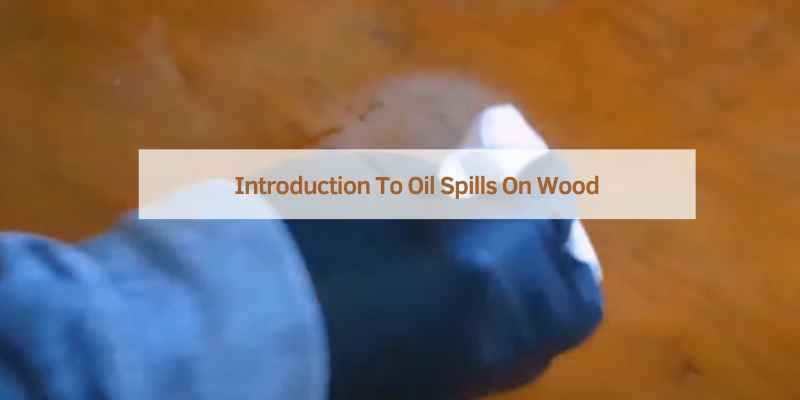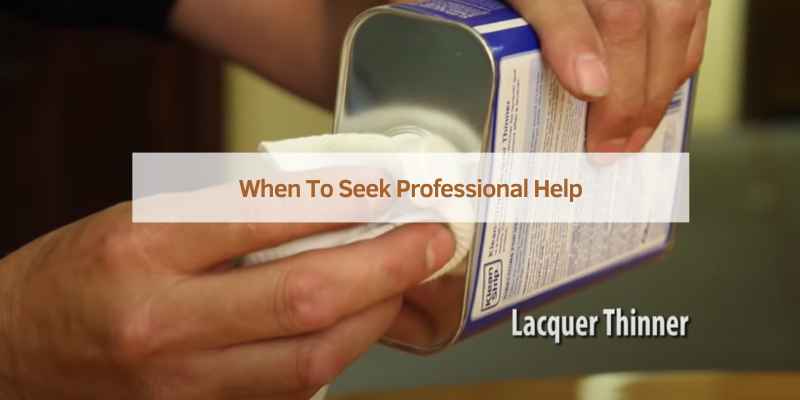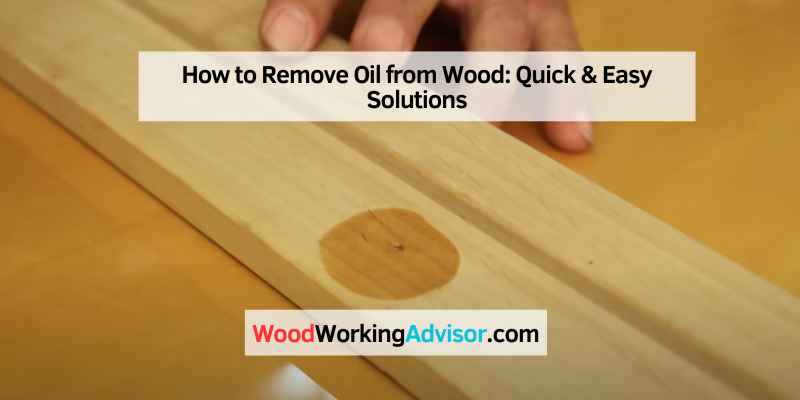To remove oil from wood, start by blotting the stain with a clean cloth and applying baking soda to absorb the oil. Then, scrub the area with a mixture of dish soap and water, and rinse with clean water.
Finally, let the wood dry completely. Removing oil from wood can be a simple process with the right materials and techniques. Whether it’s a kitchen countertop or a wooden floor, knowing how to effectively remove oil stains can help maintain the beauty and longevity of your wood surfaces.
We’ll explore various methods and tips for removing oil from wood, so you can keep your wooden items looking clean and well-maintained.
Introduction To Oil Spills On Wood
Removing oil spills on wood can be challenging, but there are effective ways to do it. One method is to sprinkle baking soda or cornstarch on the affected area, let it sit for a few minutes, and then wipe it off with a clean cloth.
Another option is to use a mixture of equal parts vinegar and water, which can also help to remove the oil stain.
Common Causes
Oil spills on wood can occur due to various reasons. Some common causes include:
- Accidental spills during cooking or oiling wooden surfaces
- Leakage from containers or bottles containing oil
- Improper handling of oil-based products near wooden furniture or flooring
Immediate Actions
When you come across an oil spill on wood, it is crucial to take immediate action to prevent the oil from penetrating deeper into the surface. Here are some steps you can follow:
- Act quickly and blot the oil spill with a clean cloth or paper towel to absorb as much oil as possible.
- Avoid rubbing the spill, as it can spread the oil and make the stain worse.
- If the spill is fresh, sprinkle a generous amount of baking soda or cornstarch over the affected area to absorb any remaining oil.
- Leave the baking soda or cornstarch on the spill for at least 15 minutes to absorb the oil.
- Afterward, use a vacuum cleaner or a soft brush to remove the baking soda or cornstarch residue.
By following these immediate actions, you can minimize the oil penetration and increase the chances of successful oil removal from the wood surface.

Materials Needed For Oil Removal
When it comes to removing oil from wood, having the right materials is essential for a successful and effective clean-up. Using the correct supplies and safety gear can make the process easier and help protect the wood from damage. In this section, we will cover the essential materials needed for oil removal, as well as the necessary safety gear to ensure a safe and efficient cleaning process.
Essential Supplies
The following table outlines the essential supplies required for removing oil from wood:
| Item | Description |
|---|---|
| White Vinegar | Effective for breaking down oil and grease. |
| Dish Soap | Helps to cut through the oil and clean the wood. |
| Soft Cloths | Ideal for gentle wiping and cleaning the wood surface. |
| Soft-bristled Brush | Useful for scrubbing and removing oil from textured wood surfaces. |
| Mineral Spirits | Works well for dissolving and removing oil-based stains. |
Safety Gear
- Protective Gloves: Wear gloves to shield your hands from direct contact with the oil and cleaning agents.
- Eye Protection: Use safety goggles to prevent any splashes from coming into contact with your eyes.
- Respirator Mask: Wear a mask to avoid inhaling fumes from the cleaning solvents.
Pre-cleaning Steps
To effectively remove oil from wood, begin with pre-cleaning steps. Start by blotting excess oil with paper towels and then apply baking soda to absorb the remaining oil. Scrub the area gently with a mixture of dish soap and warm water to lift the oil stains.
Surface Assessment
Begin by examining the wood surface for the extent of oil penetration.
Initial Wipe Down
Use a clean cloth to gently blot the excess oil from the wood surface.
Traditional Cleaning Methods
To remove oil from wood, traditional cleaning methods include using baking soda mixed with water to create a paste, applying it to the affected area, and wiping it clean with a damp cloth. Another method is to use vinegar mixed with water and rubbing it onto the stain.
Sanding the area is also an option, but should only be done as a last resort as it can damage the wood.
Wooden furniture can add warmth and charm to any home, but it can also be a magnet for oil stains. Fortunately, there are several traditional cleaning methods that can remove oil from wood. These methods are safe, effective, and affordable, making them a great choice for anyone who wants to keep their wood furniture looking its best.
Dish Soap Solution:
One of the easiest and most effective ways to remove oil from wood is to use a dish soap solution. To make this solution, simply mix a few drops of dish soap with warm water. Then, dip a soft cloth into the solution and wring out the excess water. Gently rub the stained area with the cloth, being careful not to scrub too hard. Rinse the cloth with clean water and wipe away any remaining soap residue.
Baking Soda Paste:
Another great traditional cleaning method for removing oil from wood is to use a baking soda paste. To make the paste, mix equal parts baking soda and water until it forms a thick, spreadable consistency. Apply the paste to the stained area and let it sit for a few minutes. Then, use a soft-bristled brush to gently scrub the paste into the wood. Rinse the area with clean water and wipe away any remaining paste.
These traditional cleaning methods are effective in removing oil from wood. Whether you choose to use a dish soap solution or a baking soda paste, both methods are affordable and easy to use. With a little bit of effort, your wood furniture can look as good as new!
Advanced Techniques For Stubborn Stains
Using Mineral Spirits
Apply mineral spirits to a cloth and gently rub the oil stain.
Heat Treatment
Use a hair dryer to heat the wood and absorb the oil with a cloth.
Natural And Eco-friendly Alternatives
Explore natural and eco-friendly alternatives to effectively remove oil from wood surfaces. Consider using vinegar, baking soda, or a mixture of lemon juice and water for safe and efficient oil removal without harming the environment.
Wooden furniture or floors can easily get stained with oil spills. Although there are various commercial products available to remove oil stains from wood, they often contain harsh chemicals that are harmful to the environment and human health. Therefore, it is always better to opt for natural and eco-friendly alternatives that are equally effective and safe for both the wood and the environment. In this blog post, we will discuss two such alternatives: Vinegar Solution and Lemon and Salt Scrub.
Vinegar Solution
Vinegar is a natural and safe cleaning agent that can effectively remove oil stains from wood. It is also readily available in most households. Here’s how you can make a vinegar solution to remove oil stains from wood:
- Mix equal parts of white vinegar and water in a spray bottle.
- Spray the solution on the stained area and let it sit for a few minutes.
- Use a soft cloth to wipe away the oil stain. Repeat the process if necessary.
- Finally, wipe the area with a clean and damp cloth to remove any residue.
Lemon And Salt Scrub
Lemon and salt are two natural ingredients that can effectively remove oil stains from wood. The acidic nature of lemon helps to break down the oil, while the salt acts as a gentle abrasive to scrub away the stain. Here’s how you can make a lemon and salt scrub to remove oil stains from wood:
- Cut a lemon in half and dip one half in salt.
- Scrub the stained area with the lemon half, using the salt as a gentle abrasive.
- Let the solution sit for a few minutes.
- Use a soft cloth to wipe away the oil stain. Repeat the process if necessary.
- Finally, wipe the area with a clean and damp cloth to remove any residue.
In conclusion, natural and eco-friendly alternatives like vinegar solution and lemon and salt scrub are effective in removing oil stains from wood without causing any harm to the environment or human health. So, the next time you have an oil spill on your wooden furniture or floors, try these natural alternatives instead of harsh chemicals.
Preventive Measures
When it comes to keeping your wooden furniture and surfaces free from oil stains, taking preventive measures is key. By incorporating regular maintenance and applying protective coatings, you can significantly reduce the chances of oil seeping into the wood and causing damage. Here are some effective preventive measures to consider:
Regular Maintenance
Maintaining your wooden surfaces on a regular basis is essential for their longevity. By following these simple maintenance tips, you can keep your wood looking its best:
- Wipe spills immediately: Accidents happen, and when oil spills occur, it’s important to clean them up promptly. Use a clean cloth or paper towel to blot the spill and absorb as much oil as possible.
- Regular dusting: Dusting your wooden furniture regularly helps prevent the buildup of dirt and grime, which can trap oil and cause stains.
- Gentle cleaning: Use a mild detergent or wood cleaner specifically designed for wooden surfaces. Avoid using harsh chemicals or abrasive cleaners that can damage the wood.
Protective Coatings
Applying protective coatings to your wooden surfaces creates a barrier that prevents oil from penetrating the wood. Here are some options to consider:
- Sealants: Applying a sealant, such as polyurethane or varnish, can provide a protective layer on the wood surface. Make sure to follow the manufacturer’s instructions for proper application and reapplication.
- Wax: Applying a coat of wax can create a protective barrier on the wood, preventing oil from seeping in. Be sure to choose a wax suitable for wood and apply it according to the instructions.
- Oil finishes: Using oil finishes, such as tung oil or linseed oil, can enhance the natural beauty of the wood while providing some protection against oil stains. However, keep in mind that oil finishes may require more frequent reapplication.
By implementing these preventive measures and making them a part of your regular wood care routine, you can effectively reduce the risk of oil stains and keep your wooden surfaces looking their best for years to come.
When To Seek Professional Help
To effectively remove oil from wood, it’s best to seek professional help, particularly for stubborn stains. Professional cleaners have the expertise and specialized tools to ensure the safe and thorough removal of oil without damaging the wood surface. Timing is crucial, so it’s advisable to seek assistance as soon as the spill occurs.
If you’ve attempted to remove oil from wood surfaces with no success or if you notice signs of permanent damage, it may be time to seek professional help. While some minor oil stains can be effectively addressed with DIY methods, more serious cases require the expertise of trained professionals. Here are some situations when it’s best to reach out for professional assistance:
Signs Of Permanent Damage
- Deep discoloration: If the oil has deeply penetrated the wood fibers, causing a significant and stubborn discoloration, it may be difficult to remove without professional intervention.
- Warped or cracked wood: Excessive oil saturation can lead to warping or cracking of the wood surface. In such cases, professional assessment and repair may be necessary to restore the wood’s integrity.
- Unpleasant odor: Lingering oil smells can be challenging to eliminate completely. Professional cleaners have specialized equipment and techniques to effectively remove the odor-causing substances.
- Previous unsuccessful attempts: If you have already tried various DIY methods without success, it’s best to consult professionals who have the experience and tools to tackle more stubborn oil stains.
Finding A Reputable Service
When seeking professional help, it’s essential to find a reputable service provider who specializes in wood restoration and oil stain removal. Consider the following steps:
- Research and recommendations: Start by researching local wood restoration companies and read reviews from previous customers. Ask for recommendations from friends, family, or acquaintances who may have dealt with similar issues.
- Experience and expertise: Look for professionals with extensive experience in oil stain removal from wood surfaces. Check if they have certifications or accreditations that demonstrate their expertise in the field.
- Free consultation and estimates: Many reputable service providers offer free consultations and estimates. Take advantage of this opportunity to discuss the specific details of your situation and get a clear understanding of the services they can provide.
- Insurance and guarantees: Ensure that the service provider has appropriate insurance coverage in case of any damages during the restoration process. Additionally, inquire about any guarantees they offer for their work to ensure your satisfaction.
By recognizing the signs of permanent damage and finding a reputable service provider, you can ensure that your oil-stained wood surfaces receive the professional care they need for optimal restoration.

Frequently Asked Questions
How Can I Remove Oil Stains From Wood Furniture?
To remove oil stains from wood furniture, sprinkle baking soda on the stain, let it sit for a few hours, then wipe it off. Alternatively, apply dish soap to the stain, scrub gently with a soft cloth, and wipe clean.
Can I Use Vinegar To Remove Oil From Wood?
Yes, you can use vinegar to remove oil from wood. Mix equal parts vinegar and water, apply to the oil stain, and let it sit for a few minutes. Then, wipe the area clean with a damp cloth.
Is It Safe To Use Mineral Spirits On Wood Surfaces?
Mineral spirits can be used on wood surfaces to remove oil. Apply a small amount to a clean, dry cloth and wipe the affected area. Ensure good ventilation and follow all safety precautions when using mineral spirits.
What Household Items Can I Use To Remove Oil From Wood?
Household items like baking soda, dish soap, and vinegar can effectively remove oil from wood surfaces. These items are safe to use and readily available in most homes.
Conclusion
In caring for your wood surfaces, removing oil stains is crucial. By following these tips and using natural remedies, you can effectively restore your wood’s beauty. Remember to test any new method in a hidden area first. Regular maintenance will help prevent future oil spills and maintain the wood’s integrity.


